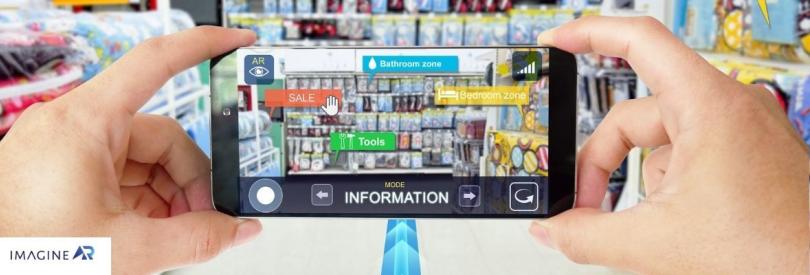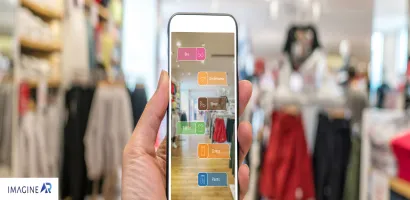
Boost Customer Satisfaction & Sales With Augmented Reality
Self-service augmented reality is helping businesses and marketers better serve their customers. It is completely transforming the way they used to communicate with their consumers.
You can improve your consumer experience by engaging content with the hint of augmented reality (AR) to make things interesting.
This post will cover all the possible instances of companies trying to successfully engage their customers with AR at each step of the buyer's journey: pre-sales, sales, and post-sales.
How Can AR Help You Enhance The Customer Experience?
AR has the potential to revolutionize the customer experience. It blends both the real and the digital worlds by overlaying & sharing images, spaces, and objects.
It is an incredible tool enabling the brands to access this tremendous opportunity to communicate with their customers three-dimensionally that too on mobile phones, right at their fingertips.
It is a new digital experience transforming the customer journey into a mesmerizing visual interaction. It helps deepen and enrich your association with the consumers serving as a persuasive mechanism to add value.
Top Trends Affecting Augmented Reality In 2021
Pre-Sale Stage: Use AR to Make the Shopping Experience Interactive
This stage concerns aspects that happen before you get a paying customer. It includes starting communication with a prospective customer, recognizing consumer needs, creating a compelling offer, overcoming obstacles, and making a sale.
At times, this stage extends for a longer period before the service or product is delivered to clients. The prime aspect of hastening the sales process is to engage customers efficiently in this phase.
1. Make the Decision Making Seamless
You can remove the uncertainty for the customers to take the next step. For instance, if consumers are contemplating an online purchase of a piece of furniture but are struggling to decide if it actually looks good in their living space or not.
You can simplify this process with AR to put things in perspective. It will help customers transform their homes into virtual showrooms and place the furniture in their homes to assess if it is perfect for their purchase using their mobile devices. It will help you consider below aspects:
- Which armchair color will suit the room decor?
- Is it the right size?
- Do you like the furniture design of its fabric?
2. Check Out the Trend Before Taking a Big Decision
Peer pressure and approval by others is a strong driver for sales. C&A, a Brazilian retailer, used it to their advantage. The cloth hangers displaying the apparel carry the number of likes it got from their social media community.
The shoppers can point at the product with their smartphone with a simple click on “look online” to access the info. This can show if one of their friends also likes that exact product. It is an incredible way for the customer to purchase without having to call and concert with their friends. It helps them decide if they want to buy it or not.
10 Ways Augmented Reality (AR) Is Revolutionizing The Retail Industry
Purchase Stage: Improve Sales With AR
This stage is when the customer makes the payment for the product or the service they purchase. The purchase can be in-store via cash or POS technology to complete the sale transaction or virtual transaction while making an online purchase through a mobile app or website.
Engagement is necessary at the purchase endpoint to ensure that the customer doesn't abandon the shopping card in both the virtual or physical purchase. You can improve your sales through visual engagement that has proven to work and deliver more conversions. It can help you eventually earn a high level of success for your business.
1. Improve Customer Experience with AR Try Before Purchase
It takes away the guesswork and helps customers choose the product by trying it out with the help of AR. There are major beauty brands that have added AR features to their app enabling the users to experience virtual makeover by trying out different lip shades, hair color, hairstyle, and other makeup products.
The mobile app uses the device camera to detect the customer's facial features to overlay the beauty product to experience what looks best and purchase accordingly. This can help them make the decision right on the spot by trying on several different products in one go, and as a result, you improve sales.
2. AR Enabled Virtual Dressing Room
The additional benefit of Augmented Reality is to try out apparel and select the garment right off the virtual shelf. The process is simple after selecting it and choosing the body shape & clothing size. It is a seamless way to experience look and feel.
Some AR-generated applications allow the user to have a 360-degree view to see its fitting from all angles, helping users select and even take the photographs to share with their friends. One example of such use is Neiman Marcus’s Memory Mirrors.
3. Immersive Experience In Retail
Immersive is the three-dimensional image that appears to surround the user. Harnessing the power of immersive AR can help you transform the retail experience entirely. Use smartphones in the store to gather info on products or services, unlock visuals, and learn about other processes.
You can use this technology to launch several virtual stores in prime locations. Such a store will attract several visitors to explore.
Post Sales Support: Strengthen the Customer Association
This stage refers to any activity that happens after the product or service is sold. It includes upgrades, troubleshooting, inquiries, warranties, repair, etc.
It is essential to engage well with the customer at this stage to cement your relationship with the customer and drive customer loyalty. It will help your business ensure customer satisfaction.
1. AR Self-Service Support
Businesses are enhancing the post-sales service to allow customers to tap into AR-based self-service. Customers can access product information like training material, manuals, and FAQs with their smartphones in an AR overlay.
For instance, Nespresso enables users to scan the packaging and access step-by-step coffee machine descaling instructions. Additionally, the AR self-service supports itself in a broad range of smart home applications.
2. AR Enabled Technical Support
Businesses can eliminate the back and forth between customer and agent interactions during technical support calls with AR visual support.
The visual support will help the consumer get information in real-time by computer vision technology. The agent instantly knows the details, like the name and model number of the malfunctioning device, which will expedite the resolution process.
3. AR-Based User Manuals
The bulky paper user manuals are things of the past? Now, the AR digital owner manual helps go through all the help to use the product to its full potential.
For instance, users can access the AR user manual for their cars with their smartphone to get info on how to check oil levels, replace air filters, etc.
Customer Experience Future With AR
Brands realize that AR is a game-changer to help address users at every stage of the buyer journey: pre-sales, sale point, and post-sale support.
Self-service Augmented Reality is an extension of AR automation. It provides your consumer's ownership in the business process, which in turn saves your time and reduces cost for both parties.
ImagineAR.com allows you to create & execute FREE mobile phone AR campaigns with no technology or programming experience.
Inform, reward, and entertain your customers with any content type, includes 3D images/content/videos activating from AR visual markers & GPS locations
.Book a free consultation with Imagine AR or contact at 818-850-2490.
Create Your Free AR Campaign Now!


